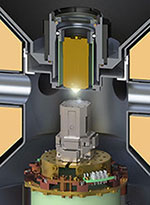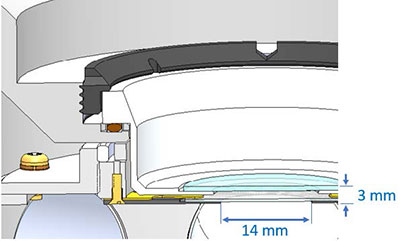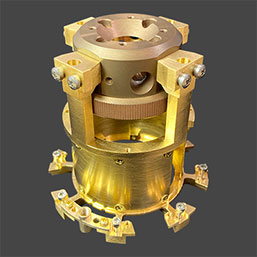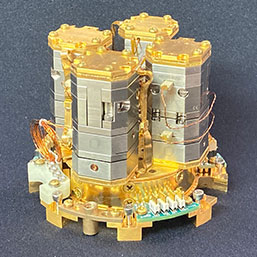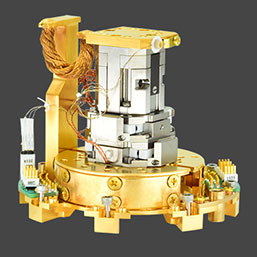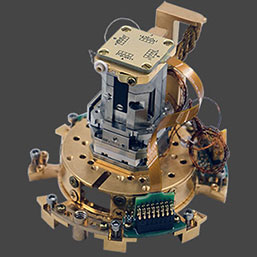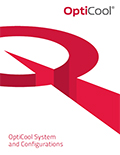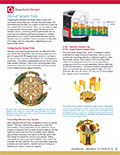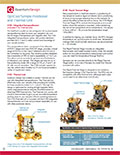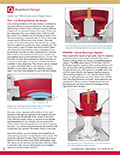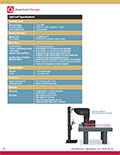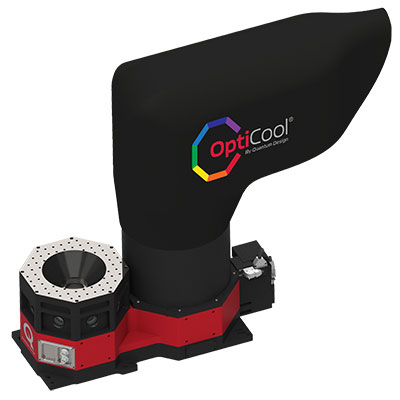
7 Tesla and Vector Magnet Optical Cryostat
Quantum Design OptiCool® and OptiCool® Vector
The cryogen-free OptiCool platform leverages Quantum Design's 40+ years' experience in engineering and manufacturing automated temperature and magnetic field control systems. With fully automated cooldown and seamless temperature control through the range of 350 K to 1.7 K, the OptiCool platform also has the low vibration and stability that is critical to optical measurements. OptiCool's innovative sample pod technology and generous 89 mm diameter by 84 mm tall sample volume provide exciting possibilities in experiment design allowing researchers to create and build customized set-ups for optical measurements. Systems feature a top window and multiple side window options to customize your optical access, including an option for a bottom window.
The standard OptiCool features a 7-tesla split-conical magnet with field perpendicular to the table and large volume of field uniformity, ±0.3% over a 3 cm diameter spherical volume. Its 7 side windows allow for unprecedented optical axis to a large experimental volume with uniform field.
The OptiCool Vector provides a magnetic field up to ±4 T perpendicular to the optical table and ±1 T in the plane parallel to the optical table. The four side windows in the X and Y axes of the magnet allow for transmission and reflection experiments in-plane parallel to the table. The top and optional bottom window in the Z direction allow for reflection or transmission experiments perpendicular to the optical table. The magnet power supplies in the OptiCool Vector allow users to precisely set the magnetic field direction relative to their sample and optical systems.
Models
7 Tesla

- 8 Optical Access Ports:
- 7 Side Ports (NA > 0.11)
- 1 Top Port (NA > 0.7)
- Optional Bottom Port
- Temperature Range: 1.7 K to 350 K
- 7 T Split-Coil Conical Magnet
- Low Vibration: <10 nm peak-to-peak
- 89 mm x 84 mm Sample Volume
- Automated Temperature & Magnet Control
- Cryogen Free
Vector Magnet
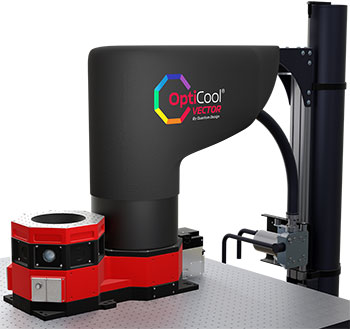
- 5 Optical Access Ports:
- 4 Side Ports (Along X and Y Axes)
- 1 Top Port (Along Z Axis)
- Optional Bottom Port
- Temperature Range: 1.7 K to 350 K
- 4(Z)-1(X)-1(Y) Vector Magnet
- Low Vibration: <10 nm peak-to-peak
- 89 mm x 84 mm Sample Volume
- Automated Temperature & Magnet Control
- Cryogen Free
OptiCool Platform Applications
- Color Center's (e.g., Diamond Nitrogen Vacancies)
- Quantum Optics
- 2D Materials (e.g., Transition Metal Dichalcogenides)
- Spintronics
- AFM / Microscopy
- MOKE / CryoMOKE
- Raman / FTIR Spectroscopy
- UV / VIS Reflectivity & Absorption
- Time Resolved Magnetic Spectroscopy
- Magneto-Excitons
- Anisotropic Magnetic Single Crystals
- Magnetic Thin Films
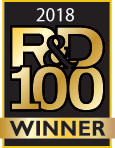
Testimonials
Customizations
Sample Pods
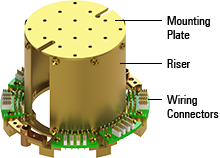
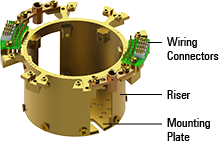
The OptiCool's Sample Pod provides a place to build and customize your experiment on the bench. When you are ready to make a measurement, the Sample Pod easily plugs into the pre-wired temperature control column. Having multiple experiments arranged on multiple pods allows you to switch experimental hardware quickly. Sample Pods are available in both a standard configuration and a large-volume configuration depending on the experimental needs. Each type of pod can be further configured by changing the riser pieces (available in three lengths; included with the system) to adjust the height of the mounting plate.
- Standard Sample Pod – Allows for mounting plate positions at 56.4 mm, 32.8 mm and 12.4 mm below the magnet center.
- Large-Volume Sample Pod – Allows for mounting plate positions at 131.3 mm, 111.0 mm and 87.4 mm below the magnet center.
Wiring and Feedthroughs
Wiring and feedthrough options are available to get electrical and optical signals into and out of the OptiCool cryostat. Wiring options are permanently mounted in the cryostat, so are usually installed at the factory. The fiber feedthrough is easily installed or removed by the end user. Pick from the following options to meet your experimental needs:
- Standard Sample Wiring – Each sample wiring assembly contains eight twisted pairs for a total of 16 wires. Four 4-pin connectors are presented on the pod to make contact to your sample.
- 3-Axis Positioner Wiring – The positioner wiring assembly is designed to be compatible with attocube piezo positioner stacks. Each assembly has enough wires to run up to 3 different axes of motion with the RES position feedback. If position feedback is not required, the feedback wires can be repurposed to run an additional 3 axes of motion. Contact Quantum Design for more information.
- RF Coax Wiring – The RF coax wiring assembly contains four coaxial cables capable of carrying high frequency signals up to 20 GHz.
- Optical Fiber Feedthrough – Feed four or more optical fibers into the sample volume. Can also be used for other items such as gas tubes.
Sample Positioning
Many optical applications require precise positioning of the sample to the optical path for focusing or examination of an area of interest. The ability to scan the sample is also required for 2D imaging of sample properties. To meet these needs the OptiCool cryostat can be configured with a piezo-based nanopositioning stack to move your sample in situ. The nanopositioner option comes with all the adapters needed to mount the nanopositioners onto a pod, specialized cryostat wiring, cabling that can connect to the piezo controller, and a thermal link specifically designed for use in the OptiCool. The nanopositioner stack can be mounted on the standard pod or on the large-volume pod depending on experimental needs. Also available is a Rapid Thermal Stage that reduces the amount of time it takes to stabilize focus on your sample when ramping or changing temperature. Additionally, we offer a Wired Sample Mount that allows users to wire their samples to the 16 pads of a removable sample mount that comes equipped with a flex wiring cable that plugs easily into the sample pod.
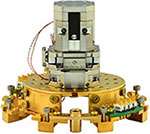
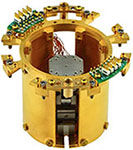
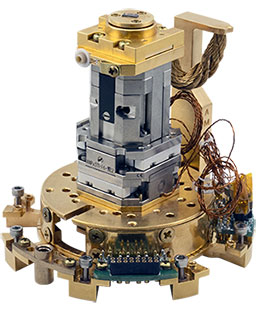
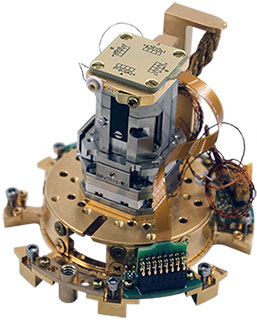
Windows and Objectives
Optical experiments can require a variety of windows and microscope objectives. To address these needs Quantum Design offers window and objective configuration options, including a low working-distance top window option, vacuum objective mounting hardware, and a bottom access window. The low working-distance top window reduces the minimum working distance from 15 mm to about 3 mm between the top of the outer window and the underside of the inner shield window. The hardware allows you to directly mount a wide variety of objectives at close spacing using the included window clamp and standard off-the-shelf adaptor rings. This means you can make adjustments or swap out objectives while the sample remains cold. Quantum Design also offers a Zeiss 100x LD EC Epiplan-Neofluar, infinity-corrected objective mounted inside the cryostat. This objective offers a 0.75 NA and a working distance of 4 mm. A kit is also available to mount your own objectives in vacuum if desired. A bottom access window is available for the cryostat, allowing transmission measurements along the magnet axis, perpendicular to the surface of the optical table.
